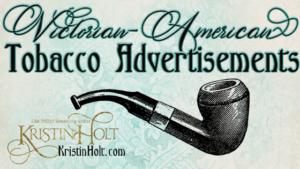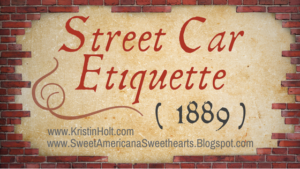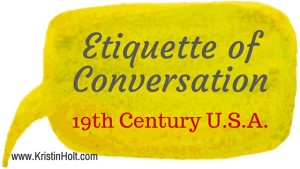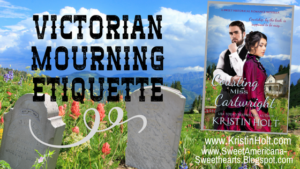.
Common Details of Western Historical Romance that are Historically INCORRECT, Part 3
.
In context of (fiction) Western Historical Romances, numerous myths abound. We’re focused on the Old West, the Victorian-era United States. Novels in this category may be set virtually anywhere in the States or her Territories from 1850 to 1900 (and beyond). Today’s myth-busting addresses tobacco in the Old West. Let’s dive in to Common Details of Western Historical Romance that are Historically Incorrect, Part 3.
.
.
INCORRECT MYTHS:
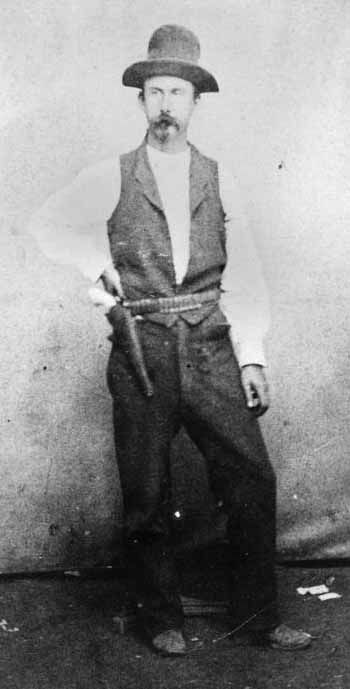
Billy Brooks, one-time lawman, turned murderer in Dodge City (1872).
A: Only Bad Guys Chewed Tobacco.
B: Good men smoked cigarettes, occasionally, and nearly always rolled their own. Those who smoked were in a stark minority.
C: Good guys smoked wherever they wanted to. The street was their smoking room.
D: Victorian Women, smoking? < shudder > Absolutely not!
E: Proper etiquette dictated men ask a woman’s permission to smoke in her presence.
TRUTHS:
A: Far more nineteenth century people smoked pipes or cigars (or chewed) than not. Tobacco was so widely used, some argued etiquette hadn’t a say one way or the other.
B: Cigars were NEW to the 19th century, and cigarettes didn’t become “it” until the 20th century.
C: Southern Ladies chewed tobacco. Throughout the nation, women did use tobacco, but in fewer numbers than men.
D: Proper etiquette for < (not!) > using tobacco on the street, or in the boudoir, or the drawing room.
E:Â The truth behind why a gentleman would never ask a lady’s permission to smoke.
.
.
Introduction
.
I love immersing myself in a well-written western historical romance. The American west calls to me, with every sun-baked stretch of desert and prairie. I can almost smell the coffee, ground moments ago. The aroma of baking bread evokes sweet memories. All of these scents enrich this Old West setting: the crush of sage beneath wagon wheels, and the ever-present aroma of tobacco from pipes, cigarettes, cigarillos, cigars, stogies, cheroots, and yes, even chewing tobacco. [Have you noticed how much the sense of smell matters in fiction?]
Have you ever noticed how much tobacco is missing from our Old West-set romances? (And frankly, from all historical romances.) Unless it’s chewing tobacco, then it always belongs to the villain, and never our hero. Never, never, never.
.
Why?
.
Because Hero must have white, shining teeth. Because, I suppose, our twenty-first century values about oral hygiene have clouded the mystique of the American Old West.
AND– by today’s standards, tobacco isn’t romantic. Tobacco kills. We know that, now. Advertisers are curtailed, and writers feel much of the same responsibility to not romanticize something far from romantic.
This brings us to the historically incorrect myth to bust in Common Details of Western Historical Romance that are Historically INCORRECT, Part 3: tobacco in everyday nineteenth century America. And not just in cities and established communities. Tobacco claimed its place on the frontier, among soldiers in “Indian Country,” in every mining camp and rail gangs building roads. Believe it or not— tobacco had an important place with southern genteel ladies.
Now, on to MYTH and TRUTH!
.
.
Vintage Statistics
.
.
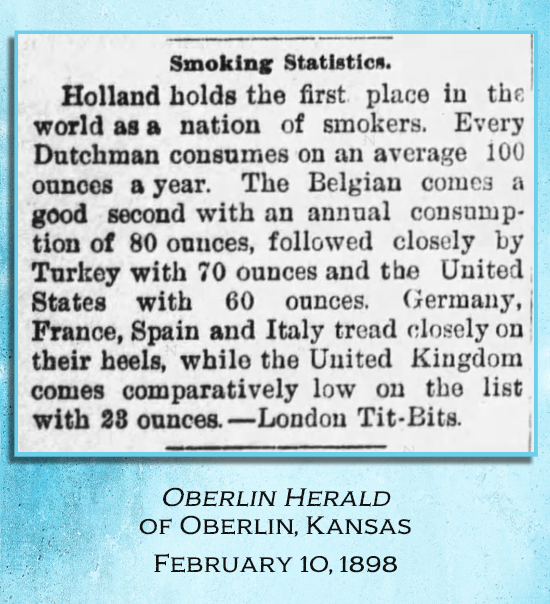
“Smoking Statistics” newspaper article, stating Americans consume 60 ounces a year (Belgians 80 oz, Holland 100 oz, Turkey 70 oz annually). Reported in Oberlin Herald of Oberlin, Kansas on February 10, 1898.
.
This newspaper clipping from an 1898 Kansas (United States) newspaper, borrowing from a London paper (apparently: “London Tit-Bits”) wherein UK smokers are stated to be the lowest smokers, consuming 28 ounces of tobacco annually. Americans come in at 60 ounces, annually, where those in Holland consume a whopping 100 ounces. Or so they say.
Parenthetically, who in the UK, Holland, Belgium, and United States? Men? Women and men? Men, women, and children? (Yes, you’ve seen pics of kids smoking thought the nineteenth century.) TODAY’S answer would be men. Adults over 21 (brand new law!). This historic 60 ounce annual average is spread over all persons.
(Women and children smoked, too. Archeologists can’t help but notice the characteristic “pipe-stem hole” in the teeth of pipe smokers.)
Here’s a photo. Claims to be an eight-year-old boy working as a coal miner. Note the pipe in his young mouth. Does he look eight to you?
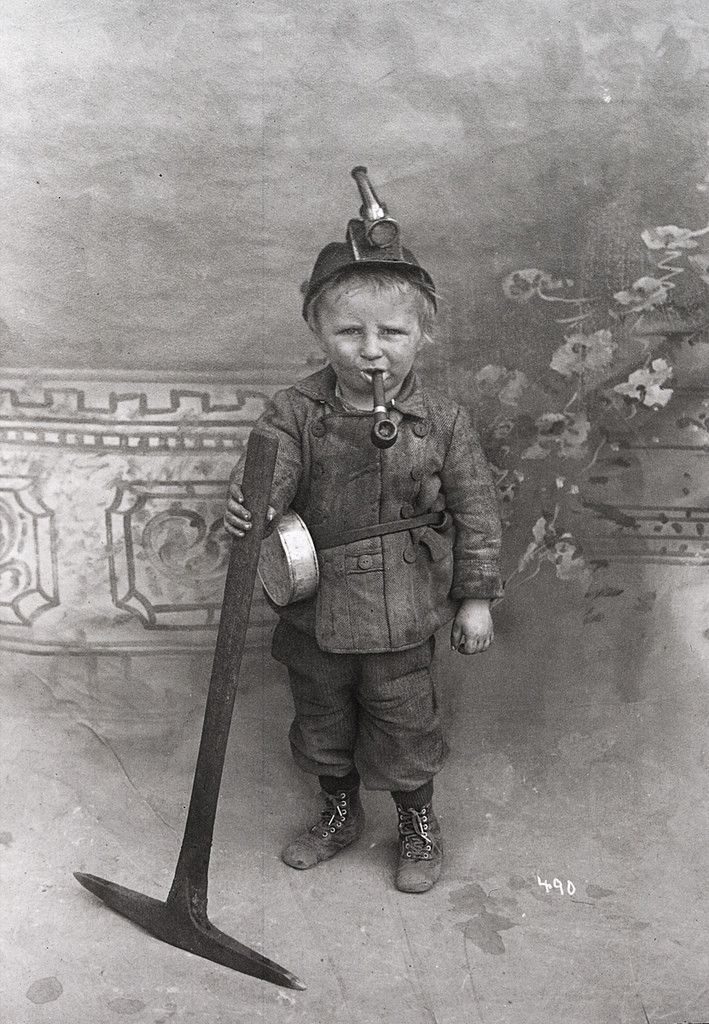
Vintage photograph labeled as an eight year old coal miner. Image courtesy of Imagur.
.
.
What did Victorian-Americans Smoke?
.
The following graph from the U.S. Department of Agriculture (1996) shows more than 100 years’ worth of per capita consumption of tobacco. Notice that the chart is cumulative. This means that to reach the almost 6 pounds of tobacco used per capita in 1880, all of the different forms were added together. Thus snuff (the darkest segment at the very top of the graph equates to that narrow band width, a fraction of the whole.
.
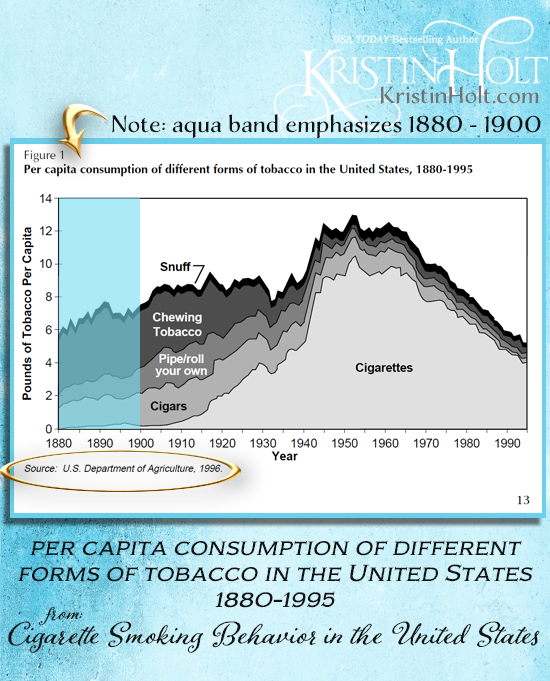
Per Capita Consumption of different forms of tobacco in the United States, 1880-1995. Showing Pounds of Tobacco per capita on the rise and the years on the run (length), we see how little cigarettes mattered to the consumption, and how much was chewed, rolled, pipes, or cigars. From the US Department of Agriculture, 1996. P. 13 of Smoking Behavior in the United States. [To view the entire PDF, search google for: Cigarette Smoking Behavior in the United States – CiteSeerX]
.
Note: For specific brands of tobacco, see my article: Victorian-American Tobacco Advertisements.
.
Cigars are “New”
.
Note the graph image once more–and see that cigar use is about half of the consumption of chewing tobacco. According to this Humboldt Union article, of Humboldt, Kansas on April 27, 1889, the “use of cigars is much more recent than most people suppose.”
.
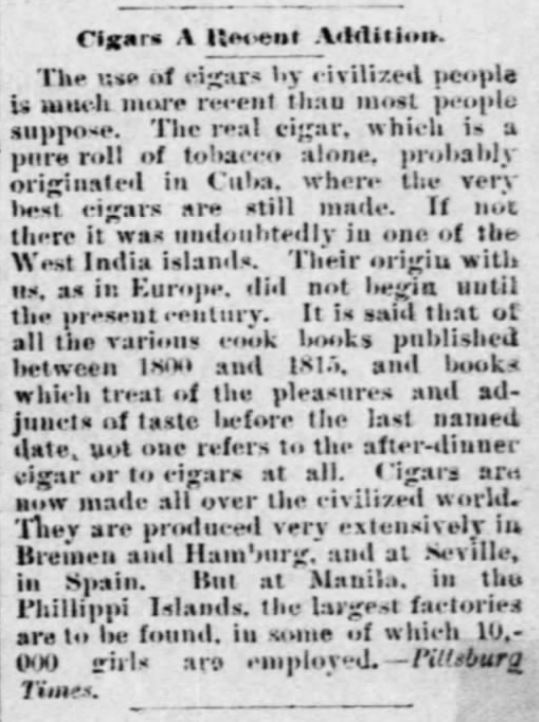
From The Humboldt Union of Humboldt, Kansas. Published April 27, 1889. “Cigars A Recent Addition” continues, “It is said that of all the various cook books published between 1800 and 1815, and books which treat of the pleasures and adjuncts of taste before the last named date, not one refers to the after-dinner cigar or to cigars at all.”
.
Two specifics surprised me:
1. Firstly:Â Cigarette use in the last two decades of the 19th century (1880 to 1900) was incredibly low. Yes, new cigarette-rolling machines had been patented. Tobacco companies advertised heavily this new “cigarette product.” But still, tobacco users from 1880 through 1900 consumed theirs via pipe, cigars, snuff, and rolling their own. Notice the very low percentage of cigarettes among all tobacco usage by year 1900.
2. Secondly:Â Snuff‘s use has continued, almost at a consistent rate, for the past 125 years. Yes, as readers of Regency-set romances, we’re used to the peerage carrying snuff boxes. But cowboys? And bankers? Painters in the Old West? Yep. Snuff use remained a consistent subset of tobacco users through all those years.
.
.
Nineteenth Century Women and Tobacco
.
Northern Ladies Smoked (sometimes in public). I kid you not.
.
Did ladies begin smoking as a prescription from doctors?
.
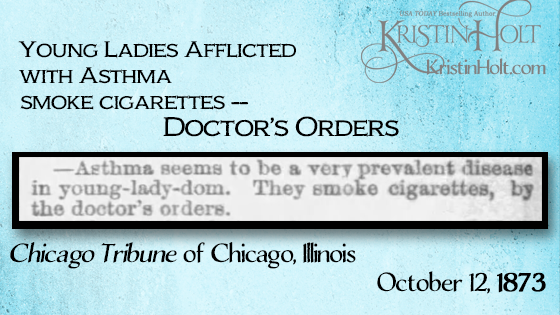
Chicago Tribune of Chicago, IL. October 12, 1873.
.
“Cigarette smoking (in Gotham) is indulged in by many young women and school girls. The thumbs and forefingers of a class in a young ladies’ school in this city were examined the other day, and only two were found to be without tobacco stains.” (transcription from Star Tribune of Minneapolis, MN on February 4, 1878.
.
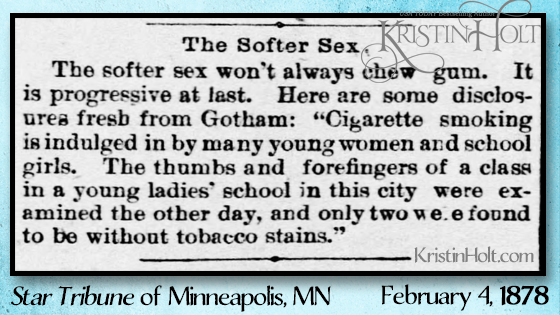
Star Tribune of Minneapolis, Minnesota on February 4, 1878.
.
A very special product: Cigarettes for Elderly Ladies:
.
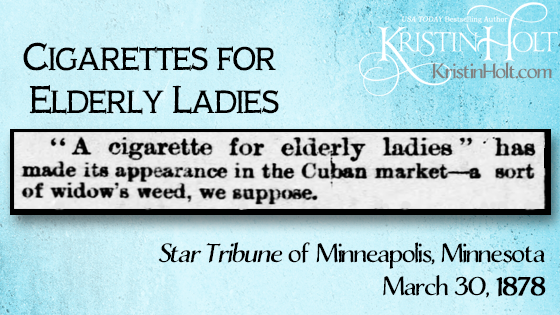
Advertised in Star Tribune of Minneapolis, Minnesota on March 30, 1878.
.
An Open Secret: many ladies in New York indulge in the fragrant cigarette!
.
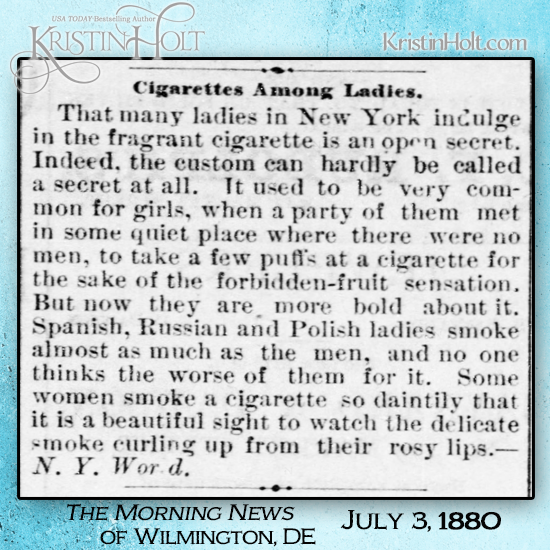
The Morning News of Wilmington, DE on July 3, 1880.
.
Women love their tobacco, according to a Chicago tobacconist (1886). So much so, he’s had a furious husband (or fifty) threaten him with personal violence if he did not quit selling to his wife. I can imagine the exchange now!
.
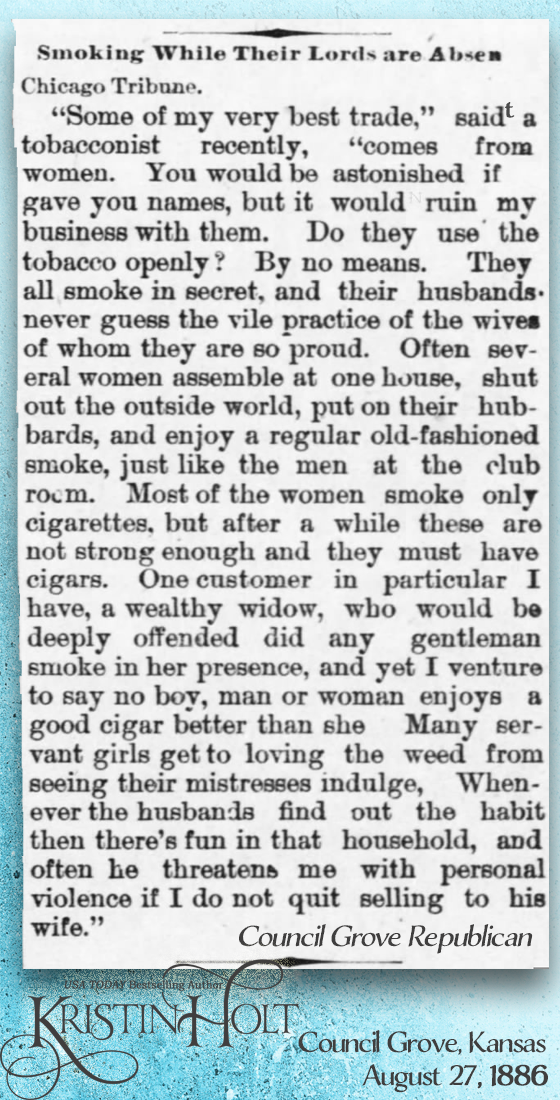
Council Grove Republican of Council Grove, KS on August 27, 1886.
.
Notice how society’s expectations changed through these last decades of the nineteenth century. What was once socially taboo (women smoking in upper-class households) became a well-respected practice.
.
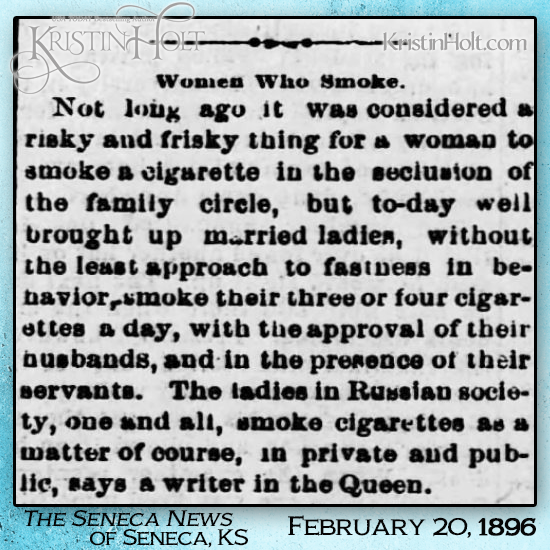
The Seneca News of Seneca, KS on Feb. 20, 1896.
.
A Question of Taste
.
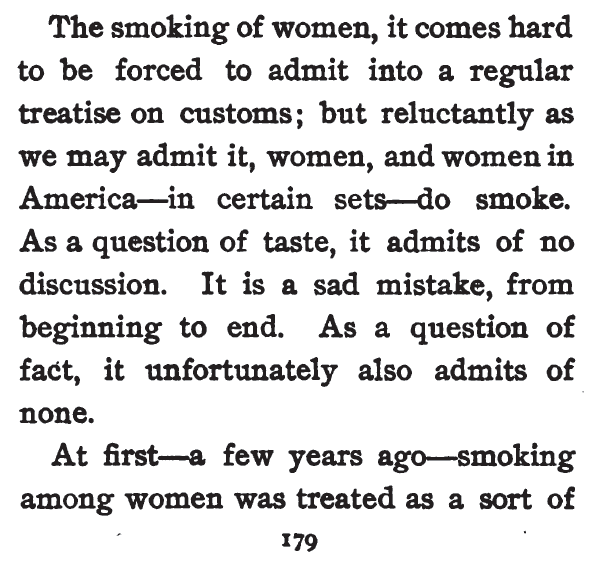
1 of 2: Smoking of Women, published 1898 in Etiquette for Americans.
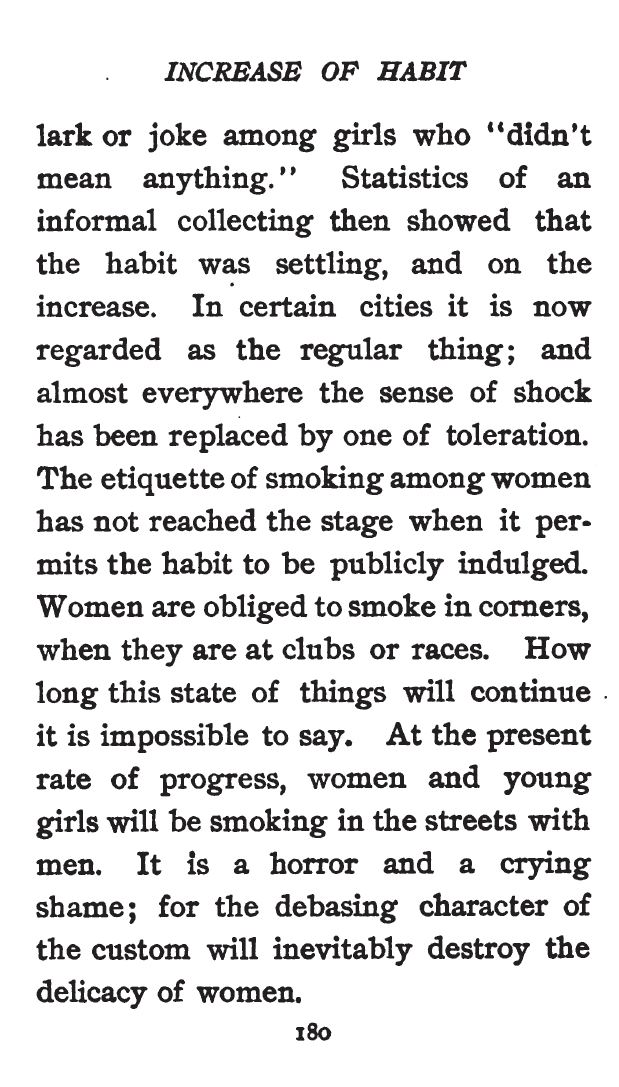
2 of 2: Smoking of Women. From 1898 publication: Etiquette for Americans.
.
Southern ladies dipped (often in public). I kid you not.
.

Shelby County Herald of Shelbyville, Missouri on 26 May 1875.
.
I read (and pursued many of the citations) within The Social Dip, Southern Women Loved Their Snuff by Rhea Cole. My jaw dropped and stayed open. I completely believe the sources backing up this American Civil-War Forum‘s article. Yes, poor white Southern women smoked corncob pipes like their grannies before them. But well-to-do ladies chewed? And snuffed. And chewed up tree sticks to use as a dipper to “dip”, instead.
.
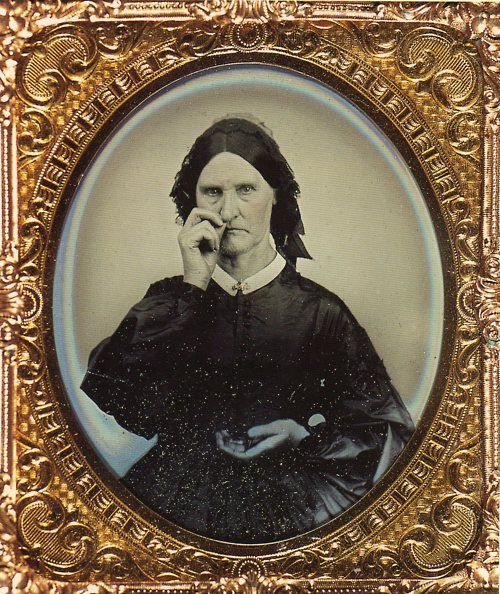
Photo courtesy of Pinterest.
.
Vicky Betts, citing [12] wrote:
What sort of Southern woman dipped snuff, smoked a pipe, or even, as a last resort, chewed tobacco? She could be either black or white. She also tended to be rural rather than urban, although that eliminated relatively few in this overwhelmingly agricultural region. Accounts appear from Texas (where Olmstead called it a “Virginia habitâ€) and Arkansas, all across the South to Georgia and the Old Dominion. It seemed to be a nearly universal habit in northern Mississippi and Alabama. A Federal refugee aid worker in Nashville declared that she “could not recall a single instance of women or good sized girls who did not use tobacco in some form.
.
Draw a breath! Wow! Have you ever seen such lengthy Victorian paragraphs?
Note: I’ve added the emphasis to this quote (both above and below this respite).
.
A young girl, a refugee from Northern Alabama, who was present, was asked if she knew of any women or girls in her section who did not smoke. Only one—her granddaddy’s folks, she said; the old man was opposed to tobacco; but his was the only family that she knew who did not use it.†An 1863 commentator estimated that “more than two-thirds of the Georgia women one sees on the railroad and at the hotels, use snuff for chewing, or ‘dipping,’ as it is called.†John Aughey, a Virginian, estimated that among poor white Southern women in his state “scarcely one in fifty of this class is exempt from the disgusting habit. . . . Every five of these will use a two-ounce paper of snuff per day.â€[12]
——–
[12] Silverthorne, 127; Nashville Dispatch, 3 October 1863, p. 2, c. 2; Lanman, 166; for a Memphis example of dipping see Bell Irvin Wiley, The Life of Billy Yank: The Common Soldier of the Union (Garden City, NY: Doubleday & Co., 1971), 101; Olmstead, The Cotton Kingdom: A Selection, 160 (first quotation); Nashville Daily Union, 3 September 1864, p. 2, c. 4; Billings, 245; Nashville Dispatch, 30 December 1864, p. 1, c. 3 (second quotation); Memphis Daily Appeal [Atlanta, GA], 4 December 1863, p. 1, c. 3 (third quotation); Aughey, 213-214 (fourth quotation).
.
.
Tobacco Etiquette
.
Let’s Bash Myth “X”:
“Madam, do you mind if I smoke?”
He’d never say that.
Why?
.
A Gentleman Never Would
.
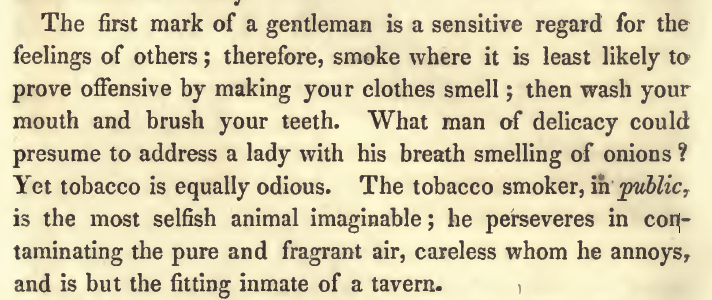
From an 1843 Publication: Etiquette or a Guide to the Usages of Society, referencing Smoking in Public.
.
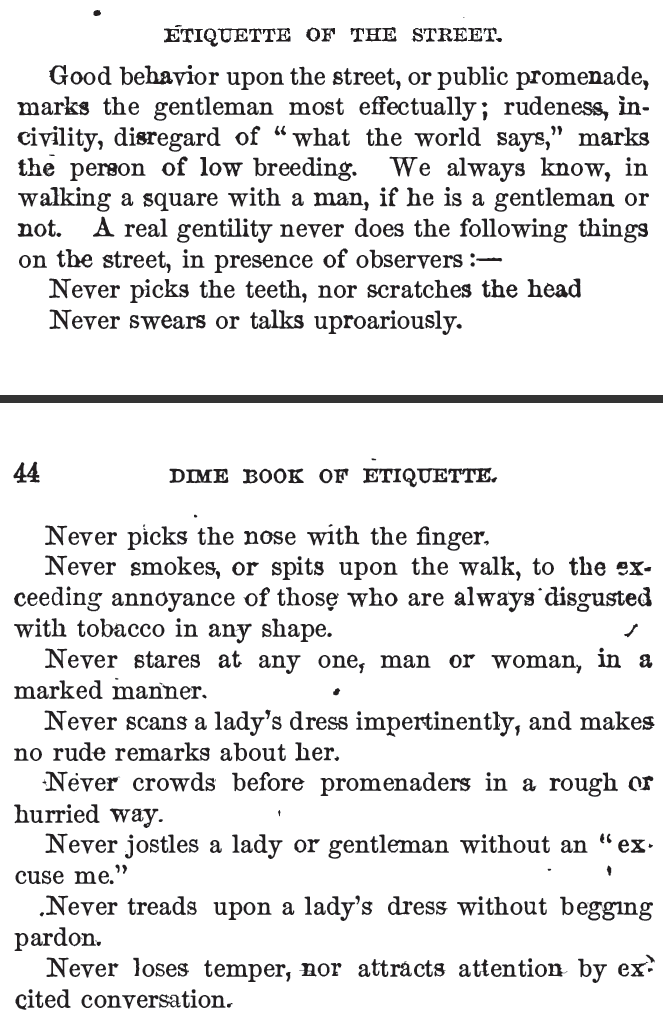
Street Etiquette includes NO smoking and NO spitting tobacco juice with the same vehemence as NO picking of the nose. Published in 1859: Beadle’s Dime Book of Practical Etiquette for Ladies and Gentlemen.
.
There you have it. A gentleman never would. A gentleman. That doesn’t necessarily exclude a poor man working for his daily bread. Nor does it exclude a well-dressed, wealthy man.
I’ve listed the following snippets of Tobacco Etiquette, continuing in chronological order. The earlier references were from Beadle’s 1859 famous etiquette Dime Book. Watch how the rules of tobacco etiquette slowly, through the last half of the nineteenth century, become less stringent.
.
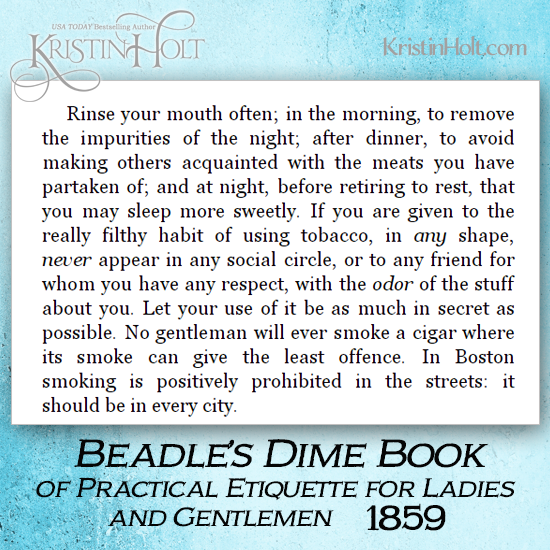
From Beadle’s Dime book of Practical Etiquette for Ladies and Gentlemen / Being a Guide to True Gentility and Good-Breeding, and a Complete Directory to the Usages and Observances of Society. Published in New York, 1859.
.
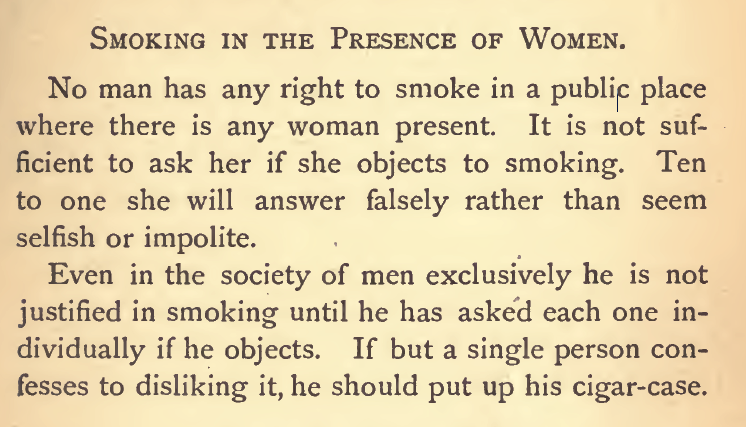
Smoking in the presence of women is never acceptable–for she’d rather answer falsely than seem selfish or impolite. DON’T ASK. DON’T SMOKE. Published in 1877: Ladies and Gentlemens Etiquette for Americans.
.
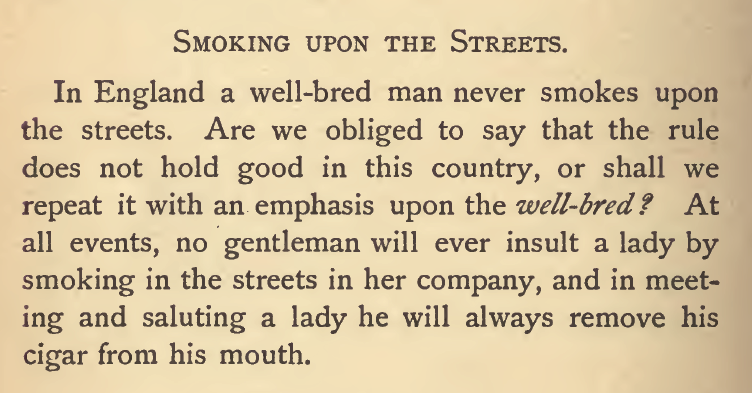
Smoking Upon the Streets; “no gentleman will ever insult a lady by smoking in the streets in her company, and in meeting and saluting a lady he will always remove his cigar from his mouth.” Published 1877, Ladies and Gentlemens Etiquette for Americans.
.
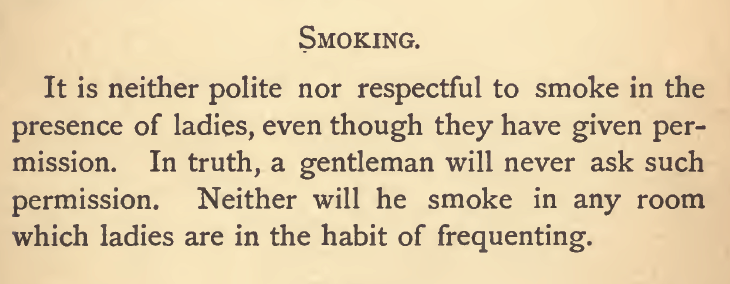
“… a gentleman will never ask such permission…”, for “it is neither polite nor respectful to smoke in the presence of ladies, even though they have given permission.” Published in 1877: Ladies and Gentlemens Etiquette for Americans.
.
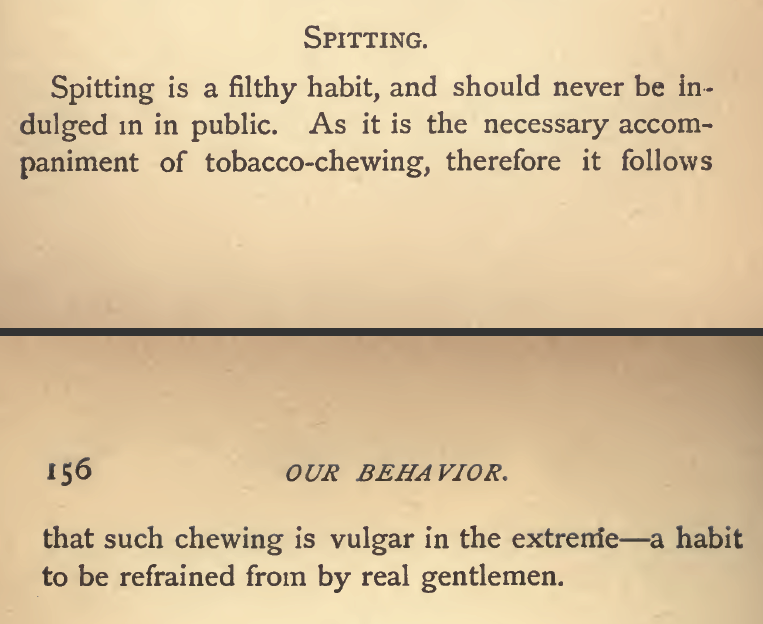
“Spitting (and therefore tobacco chewing) is a filthy habit and should never be indulged in in public.” From an 1877 publication: Ladies and Gentlemens Etiquette for Americans.
.

1877 publication: Ladies and Gentlemens Etiquette for Americans, “A well-bred man always removes his cigar from his lips whenever he bows to a lady.” Bowing was the most acceptable form of salutation and greeting.
.

1881 publication: Gems of Deportment and Hints of Etiquette. “A gentleman who is smoking will never bow to ladies without removing his cigar, and keeping it as far as possible out of their way. It is a want of respect to bow to any body and smoke at the same time.”
.
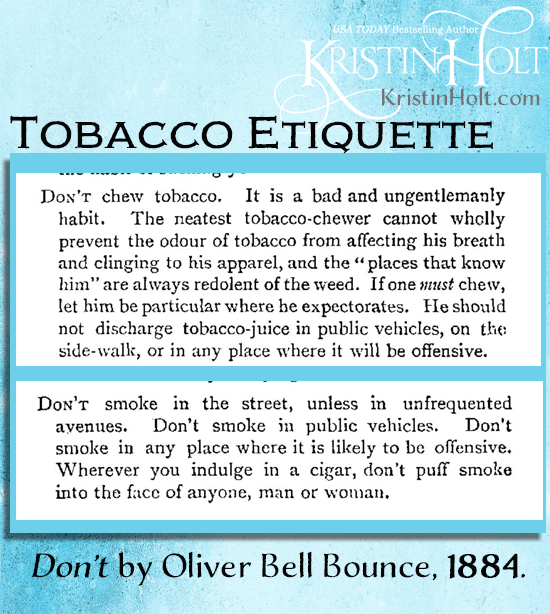
Tobacco Etiquette from 1884 publication: Don’t, by Oliver Bell Bounce.
.
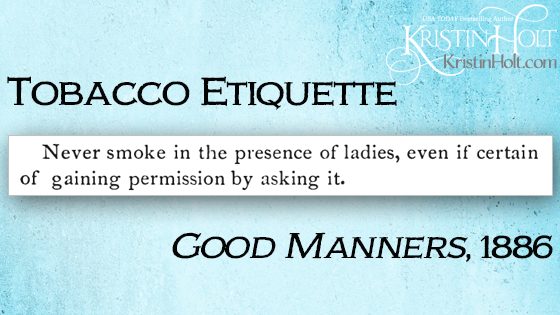
“Never smoke in the presence of ladies, even if certain of gaining permission by asking it.” From 1886 publication: Good Manners.
.
To light a cigar (cigarettes were then unknown) in the presence of a lady, or even to request her permission to do so, was then little less than a deadly insult, as the action betokened lack of respect.
.
The Cincinnati Enquirer of Cincinnati, Ohio on November 16, 1894
Note “then” refers to the earlier 19th century
Emphasis added
.
The Pendulum Swings
.
Matters of etiquette regarding tobacco use did change throughout the century. What was once highly inappropriate did become, over time, more accepted… if not truly fashionable.
Etiquette books and newspaper articles near the turn of the century often referenced more liberal rules for tobacco use in the presence of ladies.
.
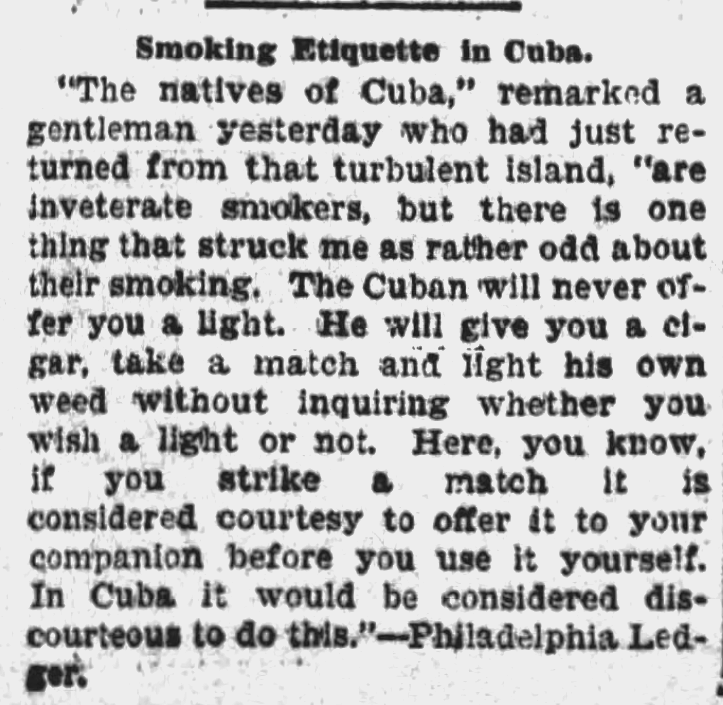
Smoking Etiquette—offering a light to a companion is proper etiquette in the USA while Cubans do not offer a light. From The Oshkosh Northwestern of Oshkosh, Wisconsin on June 11, 1897.
.
By the end of the nineteenth century, rules had relaxed, much as the “swinging pendulum” argument stated. Yet several common sense rules of deportment remained.
.
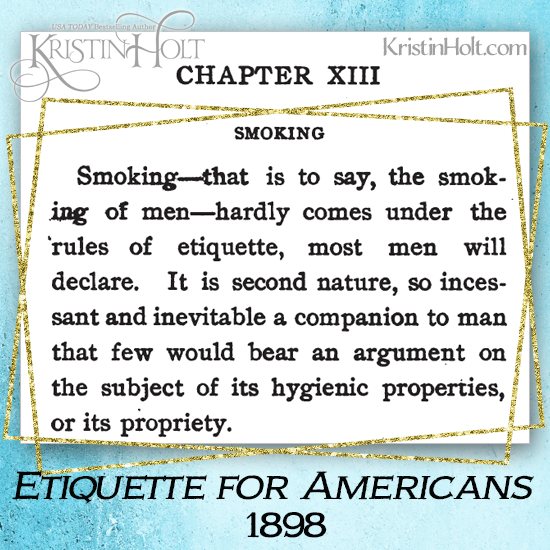
From Etiquette for Americans (1898)
.
.
Up Next:
Victorian-American Tobacco Advertisements
Vi.
.
AND
.
Smoking Kills
.
Says who?
With all this smoking and chewing going on in the nineteenth century, surely no one yet knew tobacco invites cancer. Right?
Actually, science knew far more during Victoria’s reign than you might think. Stay tuned for a soon-to-be-published article that debunks this MYTH.
.
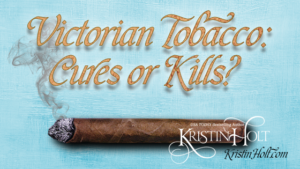
.

.
Interested?
.
.
Related Articles
Common Details of Western Historical Romance that are Historically Incorrect, Part 3.
 Common Details of Western Historical Romance that are Historically INCORRECT, Part 3
Common Details of Western Historical Romance that are Historically INCORRECT, Part 3
Copyright © 2020 Kristin Holt LC


